Abstract
DNA fragments derived from the Clostridium botulinum type A neurotoxin (BoNT/A) gene (botA) were used in DNA-DNA hybridization reactions to derive a restriction map of the region of the C. botulinum type B strain Danish chromosome encoding botB. As the one probe encoded part of the BoNT/A heavy (H) chain and the other encoded part of the light (L) chain, the position and orientation of botB relative to this map were established. The temperature at which hybridization occurred indicated that a higher degree of DNA homology occurred between the two genes in the H-chain-encoding region. By using the derived restriction map data, a 2.1-kb BglII-XbaI fragment encoding the entire BoNT/B L chain and 108 amino acids of the H chain was cloned and characterized by nucleotide sequencing. A contiguous 1.8-kb XbaI fragment encoding a further 623 amino acids of the H chain was also cloned. The 3' end of the gene was obtained by cloning a 1.6-kb fragment amplified from genomic DNA by inverse polymerase chain reaction. Translation of the nucleotide sequence derived from all three clones demonstrated that BoNT/B was composed of 1,291 amino acids. Comparative alignment of its sequence with all currently characterized BoNTs (A, C, D, and E) and tetanus toxin (TeTx) showed that a wide variation in percent homology occurred dependent on which component of the dichain was compared. Thus, the L chain of BoNT/B exhibits the greatest degree of homology (50% identity) with the TeTx L chain, whereas its H chain is most homologous (48% identity) with the BoNT/A H chain. Overall, the six neurotoxins were shown to be composed of highly conserved amino acid domains interceded with amino acid tracts exhibiting little overall similarity. In total, 68 amino acids of an average of 442 are absolutely conserved between L chains and 110 of 845 amino acids are conserved between H chains. Conservation of Trp residues (one in the L chain and nine in the H chain) was particularly striking. The most divergent region corresponds to the extreme carboxy terminus of each toxin, which may reflect differences in specificity of binding to neurone acceptor sites.
Full text
PDF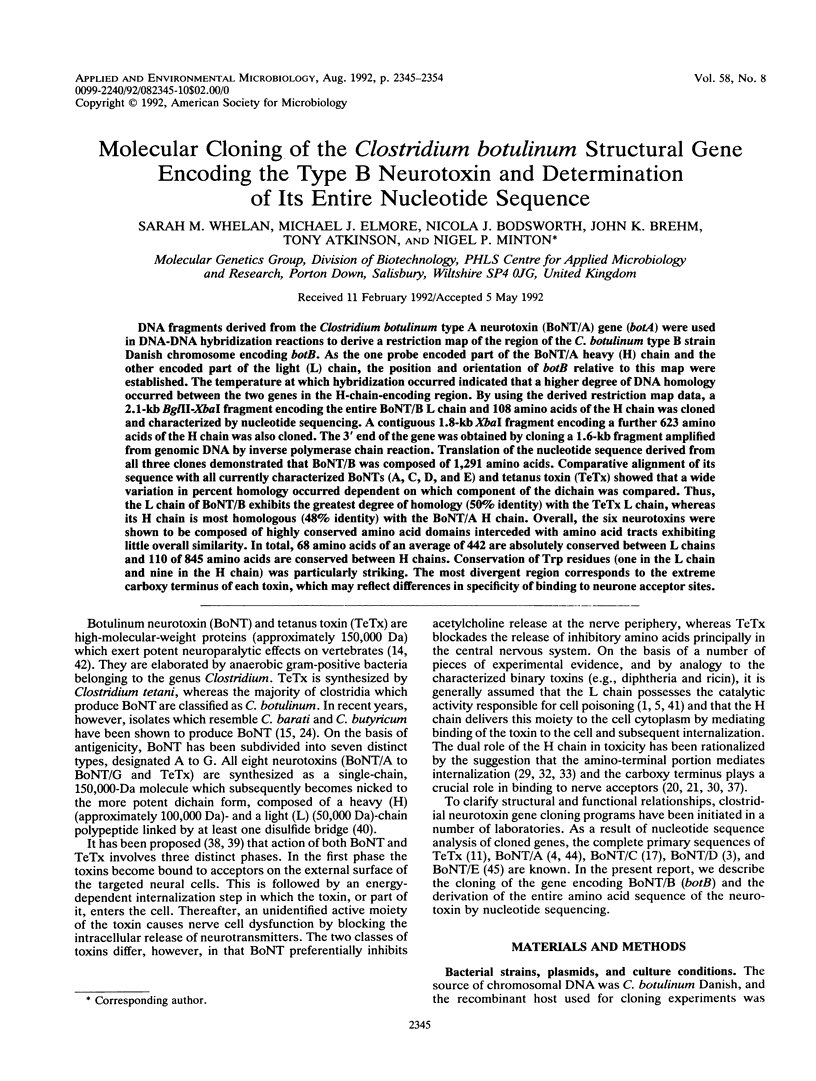
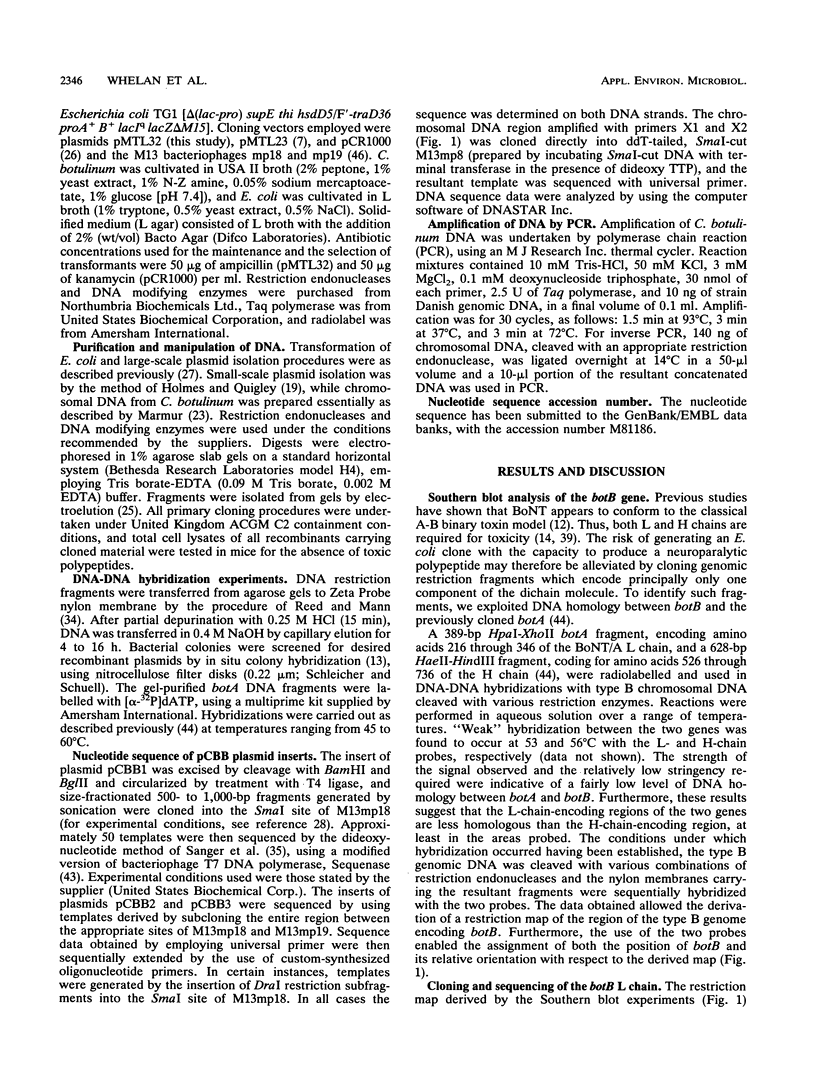
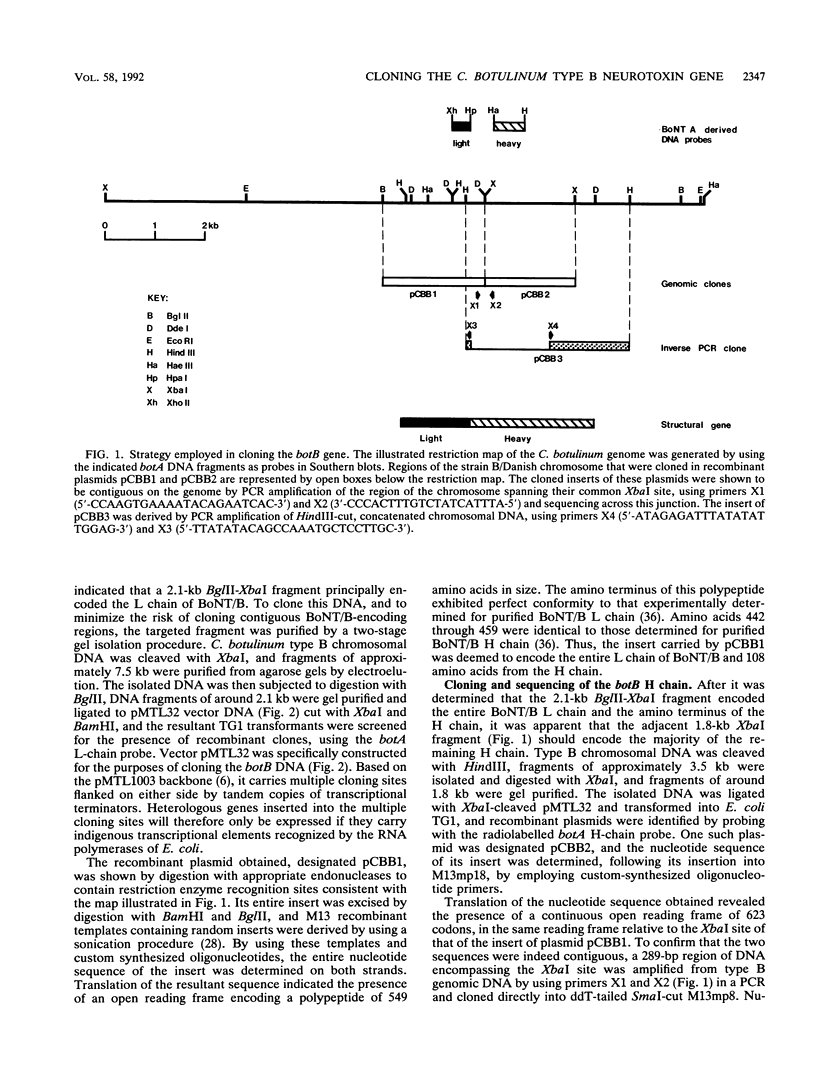
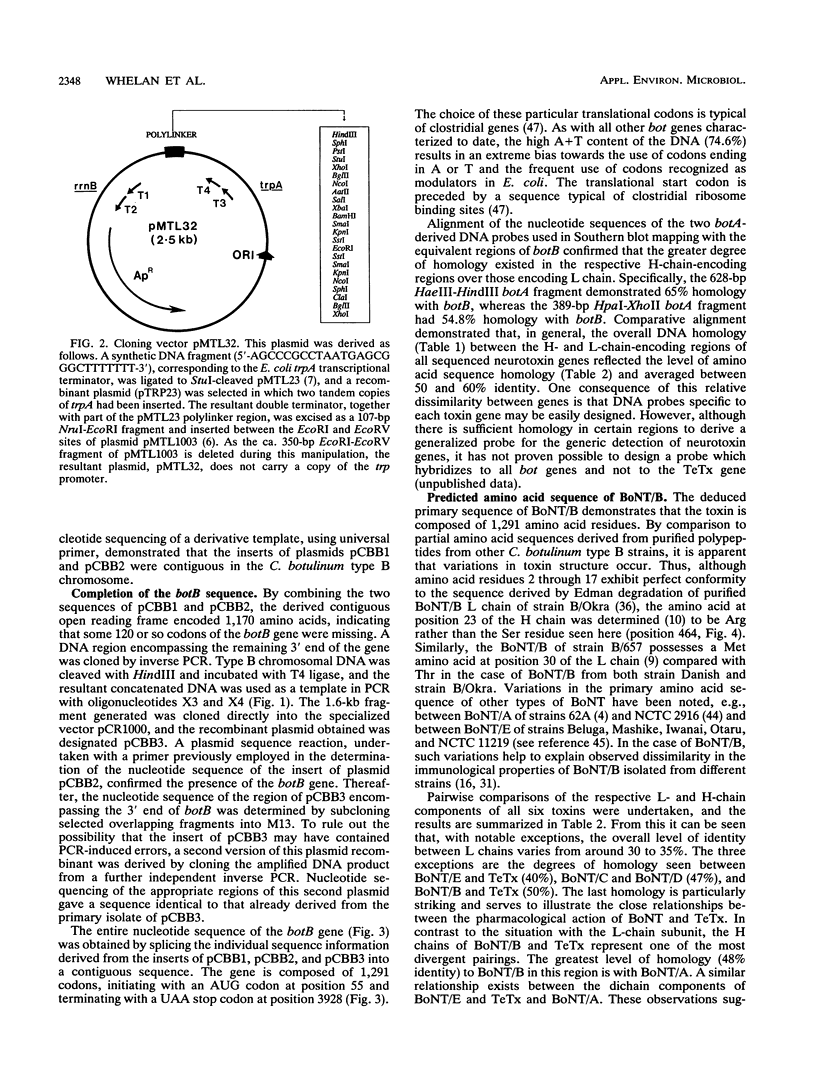
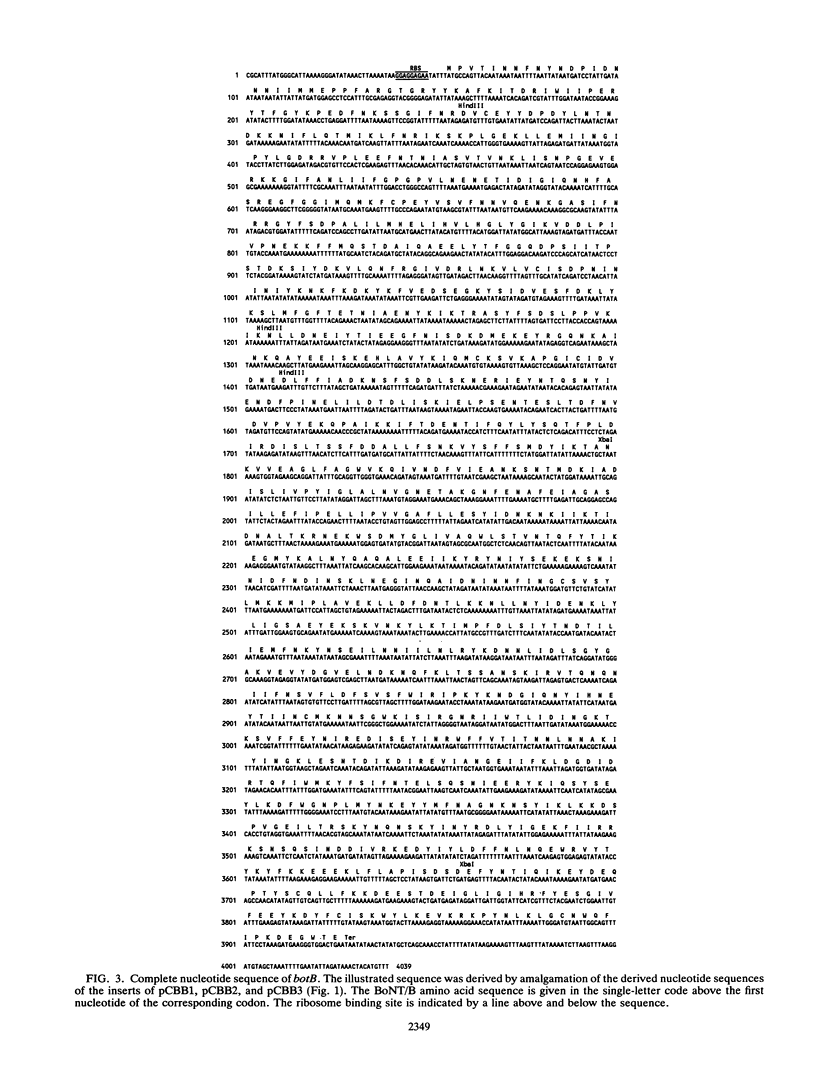
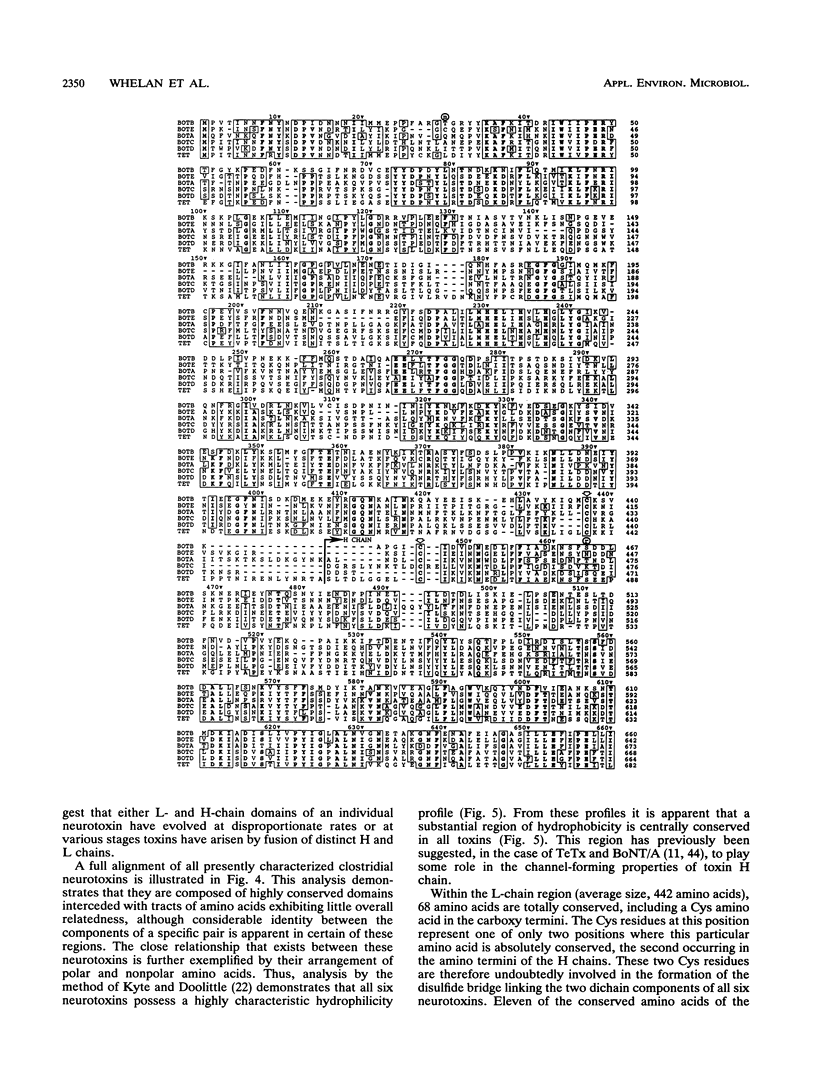
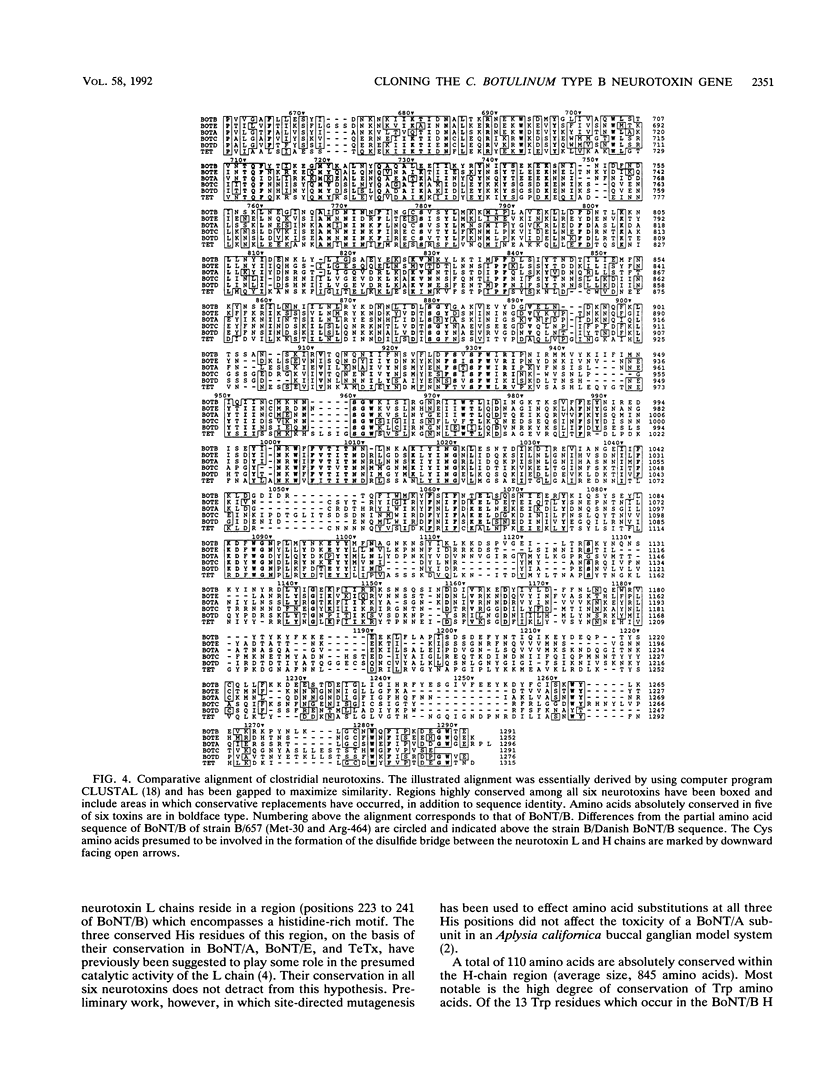
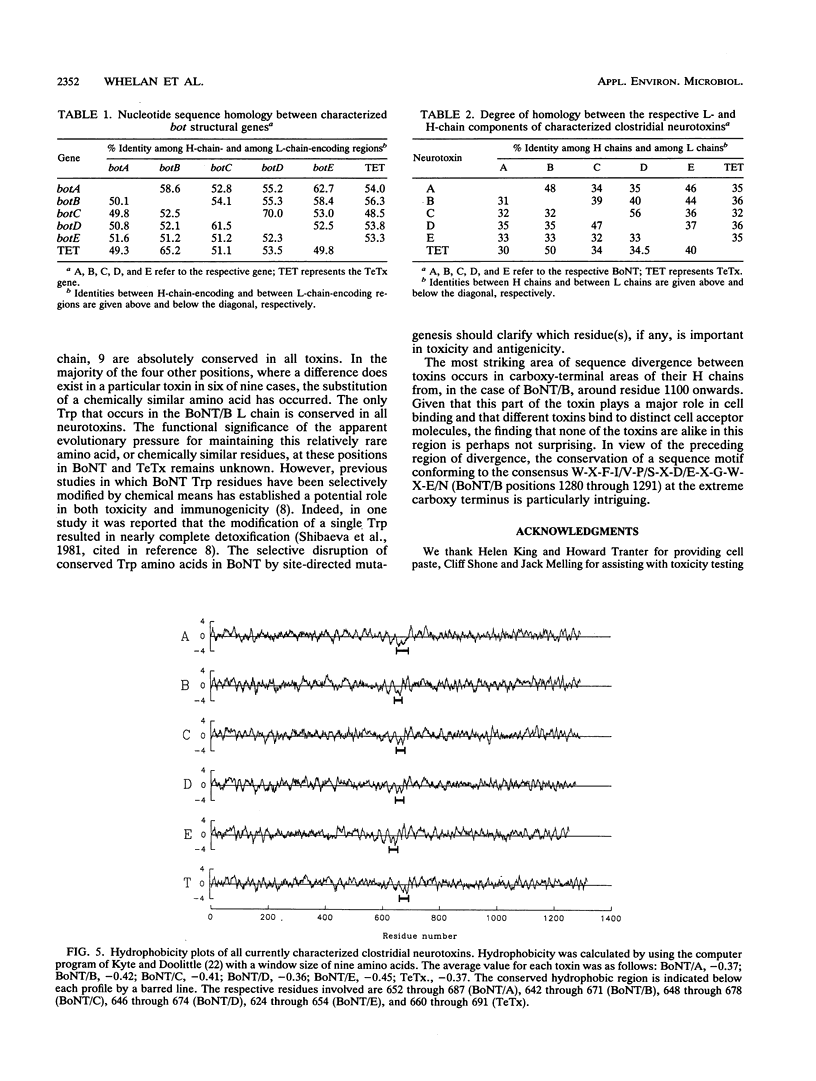
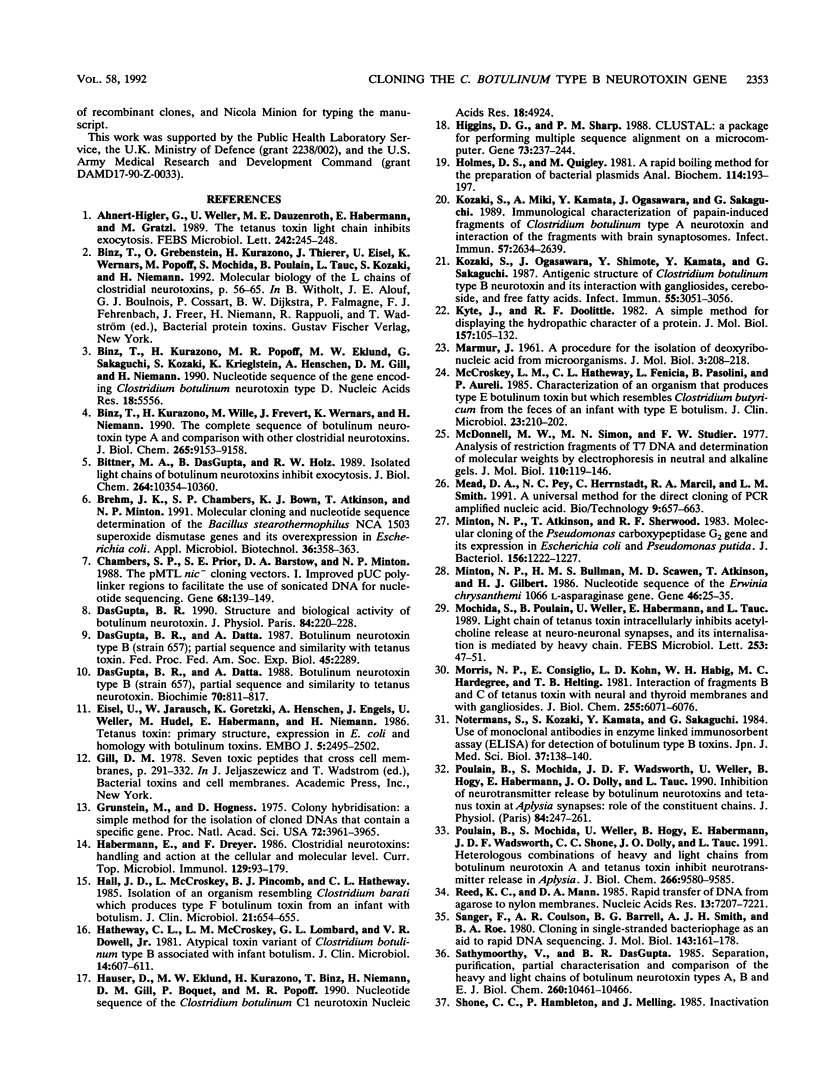
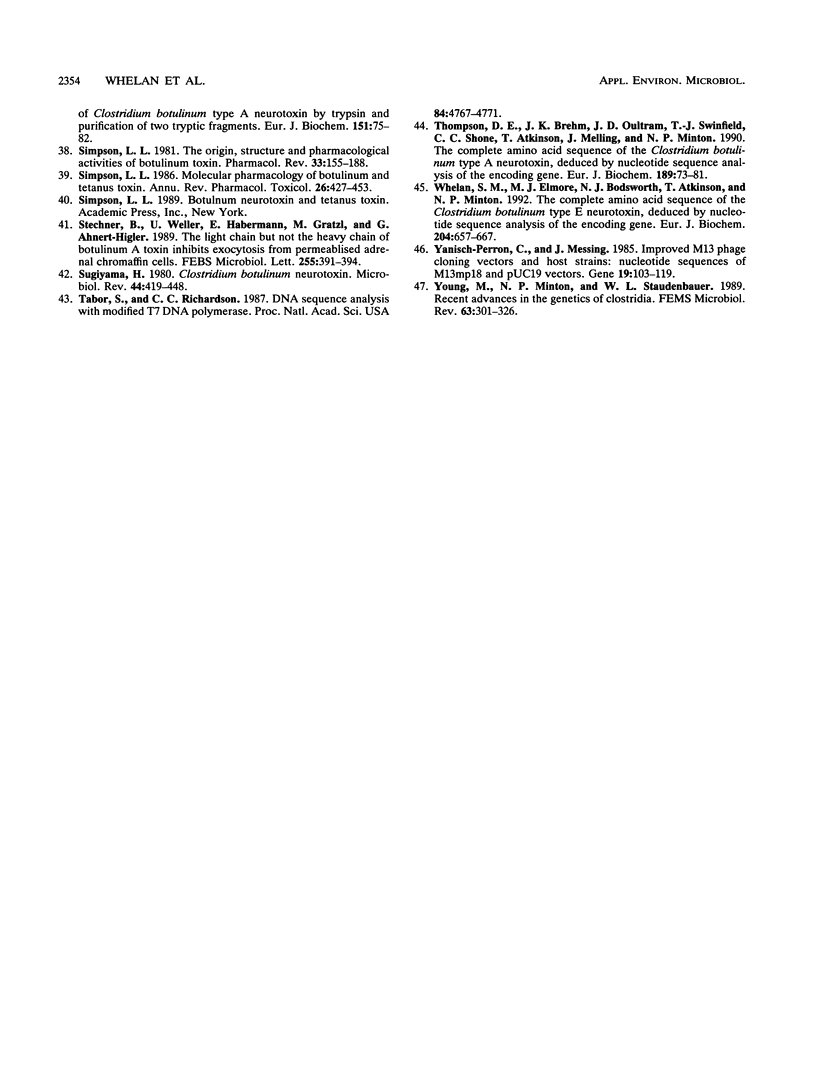
Selected References
These references are in PubMed. This may not be the complete list of references from this article.
- Ahnert-Hilger G., Weller U., Dauzenroth M. E., Habermann E., Gratzl M. The tetanus toxin light chain inhibits exocytosis. FEBS Lett. 1989 Jan 2;242(2):245–248. doi: 10.1016/0014-5793(89)80478-8. [DOI] [PubMed] [Google Scholar]
- Binz T., Kurazono H., Popoff M. R., Eklund M. W., Sakaguchi G., Kozaki S., Krieglstein K., Henschen A., Gill D. M., Niemann H. Nucleotide sequence of the gene encoding Clostridium botulinum neurotoxin type D. Nucleic Acids Res. 1990 Sep 25;18(18):5556–5556. doi: 10.1093/nar/18.18.5556. [DOI] [PMC free article] [PubMed] [Google Scholar]
- Binz T., Kurazono H., Wille M., Frevert J., Wernars K., Niemann H. The complete sequence of botulinum neurotoxin type A and comparison with other clostridial neurotoxins. J Biol Chem. 1990 Jun 5;265(16):9153–9158. [PubMed] [Google Scholar]
- Bittner M. A., DasGupta B. R., Holz R. W. Isolated light chains of botulinum neurotoxins inhibit exocytosis. Studies in digitonin-permeabilized chromaffin cells. J Biol Chem. 1989 Jun 25;264(18):10354–10360. [PubMed] [Google Scholar]
- Brehm J. K., Chambers S. P., Brown K. J., Atkinson T., Minton N. P. Molecular cloning and nucleotide sequence determination of the Bacillus stearothermophilus NCA 1503 superoxide dismutase gene and its overexpression in Escherichia coli. Appl Microbiol Biotechnol. 1991 Dec;36(3):358–363. doi: 10.1007/BF00208156. [DOI] [PubMed] [Google Scholar]
- Chambers S. P., Prior S. E., Barstow D. A., Minton N. P. The pMTL nic- cloning vectors. I. Improved pUC polylinker regions to facilitate the use of sonicated DNA for nucleotide sequencing. Gene. 1988 Aug 15;68(1):139–149. doi: 10.1016/0378-1119(88)90606-3. [DOI] [PubMed] [Google Scholar]
- DasGupta B. R. Structure and biological activity of botulinum neurotoxin. J Physiol (Paris) 1990;84(3):220–228. [PubMed] [Google Scholar]
- Dasgupta B. R., Datta A. Botulinum neurotoxin type B (strain 657): partial sequence and similarity with tetanus toxin. Biochimie. 1988 Jun;70(6):811–817. doi: 10.1016/0300-9084(88)90111-3. [DOI] [PubMed] [Google Scholar]
- Eisel U., Jarausch W., Goretzki K., Henschen A., Engels J., Weller U., Hudel M., Habermann E., Niemann H. Tetanus toxin: primary structure, expression in E. coli, and homology with botulinum toxins. EMBO J. 1986 Oct;5(10):2495–2502. doi: 10.1002/j.1460-2075.1986.tb04527.x. [DOI] [PMC free article] [PubMed] [Google Scholar]
- Grunstein M., Hogness D. S. Colony hybridization: a method for the isolation of cloned DNAs that contain a specific gene. Proc Natl Acad Sci U S A. 1975 Oct;72(10):3961–3965. doi: 10.1073/pnas.72.10.3961. [DOI] [PMC free article] [PubMed] [Google Scholar]
- Habermann E., Dreyer F. Clostridial neurotoxins: handling and action at the cellular and molecular level. Curr Top Microbiol Immunol. 1986;129:93–179. doi: 10.1007/978-3-642-71399-6_2. [DOI] [PubMed] [Google Scholar]
- Hall J. D., McCroskey L. M., Pincomb B. J., Hatheway C. L. Isolation of an organism resembling Clostridium barati which produces type F botulinal toxin from an infant with botulism. J Clin Microbiol. 1985 Apr;21(4):654–655. doi: 10.1128/jcm.21.4.654-655.1985. [DOI] [PMC free article] [PubMed] [Google Scholar]
- Hatheway C. L., McCroskey L. M., Lombard G. L., Dowell V. R., Jr Atypical toxin variant of Clostridium botulinum type B associated with infant botulism. J Clin Microbiol. 1981 Dec;14(6):607–611. doi: 10.1128/jcm.14.6.607-611.1981. [DOI] [PMC free article] [PubMed] [Google Scholar]
- Hauser D., Eklund M. W., Kurazono H., Binz T., Niemann H., Gill D. M., Boquet P., Popoff M. R. Nucleotide sequence of Clostridium botulinum C1 neurotoxin. Nucleic Acids Res. 1990 Aug 25;18(16):4924–4924. doi: 10.1093/nar/18.16.4924. [DOI] [PMC free article] [PubMed] [Google Scholar]
- Higgins D. G., Sharp P. M. CLUSTAL: a package for performing multiple sequence alignment on a microcomputer. Gene. 1988 Dec 15;73(1):237–244. doi: 10.1016/0378-1119(88)90330-7. [DOI] [PubMed] [Google Scholar]
- Holmes D. S., Quigley M. A rapid boiling method for the preparation of bacterial plasmids. Anal Biochem. 1981 Jun;114(1):193–197. doi: 10.1016/0003-2697(81)90473-5. [DOI] [PubMed] [Google Scholar]
- Kozaki S., Miki A., Kamata Y., Ogasawara J., Sakaguchi G. Immunological characterization of papain-induced fragments of Clostridium botulinum type A neurotoxin and interaction of the fragments with brain synaptosomes. Infect Immun. 1989 Sep;57(9):2634–2639. doi: 10.1128/iai.57.9.2634-2639.1989. [DOI] [PMC free article] [PubMed] [Google Scholar]
- Kozaki S., Ogasawara J., Shimote Y., Kamata Y., Sakaguchi G. Antigenic structure of Clostridium botulinum type B neurotoxin and its interaction with gangliosides, cerebroside, and free fatty acids. Infect Immun. 1987 Dec;55(12):3051–3056. doi: 10.1128/iai.55.12.3051-3056.1987. [DOI] [PMC free article] [PubMed] [Google Scholar]
- Kyte J., Doolittle R. F. A simple method for displaying the hydropathic character of a protein. J Mol Biol. 1982 May 5;157(1):105–132. doi: 10.1016/0022-2836(82)90515-0. [DOI] [PubMed] [Google Scholar]
- McCroskey L. M., Hatheway C. L., Fenicia L., Pasolini B., Aureli P. Characterization of an organism that produces type E botulinal toxin but which resembles Clostridium butyricum from the feces of an infant with type E botulism. J Clin Microbiol. 1986 Jan;23(1):201–202. doi: 10.1128/jcm.23.1.201-202.1986. [DOI] [PMC free article] [PubMed] [Google Scholar]
- McDonell M. W., Simon M. N., Studier F. W. Analysis of restriction fragments of T7 DNA and determination of molecular weights by electrophoresis in neutral and alkaline gels. J Mol Biol. 1977 Feb 15;110(1):119–146. doi: 10.1016/s0022-2836(77)80102-2. [DOI] [PubMed] [Google Scholar]
- Mead D. A., Pey N. K., Herrnstadt C., Marcil R. A., Smith L. M. A universal method for the direct cloning of PCR amplified nucleic acid. Biotechnology (N Y) 1991 Jul;9(7):657–663. doi: 10.1038/nbt0791-657. [DOI] [PubMed] [Google Scholar]
- Minton N. P., Atkinson T., Sherwood R. F. Molecular cloning of the Pseudomonas carboxypeptidase G2 gene and its expression in Escherichia coli and Pseudomonas putida. J Bacteriol. 1983 Dec;156(3):1222–1227. doi: 10.1128/jb.156.3.1222-1227.1983. [DOI] [PMC free article] [PubMed] [Google Scholar]
- Minton N. P., Bullman H. M., Scawen M. D., Atkinson T., Gilbert H. J. Nucleotide sequence of the Erwinia chrysanthemi NCPPB 1066 L-asparaginase gene. Gene. 1986;46(1):25–35. doi: 10.1016/0378-1119(86)90163-0. [DOI] [PubMed] [Google Scholar]
- Mochida S., Poulain B., Weller U., Habermann E., Tauc L. Light chain of tetanus toxin intracellularly inhibits acetylcholine release at neuro-neuronal synapses, and its internalization is mediated by heavy chain. FEBS Lett. 1989 Aug 14;253(1-2):47–51. doi: 10.1016/0014-5793(89)80926-3. [DOI] [PubMed] [Google Scholar]
- Morris N. P., Consiglio E., Kohn L. D., Habig W. H., Hardegree M. C., Helting T. B. Interaction of fragments B and C of tetanus toxin with neural and thyroid membranes and with gangliosides. J Biol Chem. 1980 Jul 10;255(13):6071–6076. [PubMed] [Google Scholar]
- Notermans S., Kozaki S., Kamata Y., Sakaguchi G. Use of monoclonal antibodies in enzyme linked immunosorbent assay (ELISA) for detection of botulinum type B toxins. Jpn J Med Sci Biol. 1984 Jun;37(3):137–140. doi: 10.7883/yoken1952.37.137. [DOI] [PubMed] [Google Scholar]
- Poulain B., Mochida S., Wadsworth J. D., Weller U., Habermann E., Dolly J. O., Tauc L. Inhibition of neurotransmitter release by botulinum neurotoxins and tetanus toxin at Aplysia synapses: role of the constituent chains. J Physiol (Paris) 1990;84(4):247–261. [PubMed] [Google Scholar]
- Poulain B., Mochida S., Weller U., Högy B., Habermann E., Wadsworth J. D., Shone C. C., Dolly J. O., Tauc L. Heterologous combinations of heavy and light chains from botulinum neurotoxin A and tetanus toxin inhibit neurotransmitter release in Aplysia. J Biol Chem. 1991 May 25;266(15):9580–9585. [PubMed] [Google Scholar]
- Reed K. C., Mann D. A. Rapid transfer of DNA from agarose gels to nylon membranes. Nucleic Acids Res. 1985 Oct 25;13(20):7207–7221. doi: 10.1093/nar/13.20.7207. [DOI] [PMC free article] [PubMed] [Google Scholar]
- Sanger F., Coulson A. R., Barrell B. G., Smith A. J., Roe B. A. Cloning in single-stranded bacteriophage as an aid to rapid DNA sequencing. J Mol Biol. 1980 Oct 25;143(2):161–178. doi: 10.1016/0022-2836(80)90196-5. [DOI] [PubMed] [Google Scholar]
- Sathyamoorthy V., DasGupta B. R. Separation, purification, partial characterization and comparison of the heavy and light chains of botulinum neurotoxin types A, B, and E. J Biol Chem. 1985 Sep 5;260(19):10461–10466. [PubMed] [Google Scholar]
- Simpson L. L. Molecular pharmacology of botulinum toxin and tetanus toxin. Annu Rev Pharmacol Toxicol. 1986;26:427–453. doi: 10.1146/annurev.pa.26.040186.002235. [DOI] [PubMed] [Google Scholar]
- Simpson L. L. The origin, structure, and pharmacological activity of botulinum toxin. Pharmacol Rev. 1981 Sep;33(3):155–188. [PubMed] [Google Scholar]
- Stecher B., Weller U., Habermann E., Gratzl M., Ahnert-Hilger G. The light chain but not the heavy chain of botulinum A toxin inhibits exocytosis from permeabilized adrenal chromaffin cells. FEBS Lett. 1989 Sep 25;255(2):391–394. doi: 10.1016/0014-5793(89)81129-9. [DOI] [PubMed] [Google Scholar]
- Sugiyama H. Clostridium botulinum neurotoxin. Microbiol Rev. 1980 Sep;44(3):419–448. doi: 10.1128/mr.44.3.419-448.1980. [DOI] [PMC free article] [PubMed] [Google Scholar]
- Tabor S., Richardson C. C. DNA sequence analysis with a modified bacteriophage T7 DNA polymerase. Proc Natl Acad Sci U S A. 1987 Jul;84(14):4767–4771. doi: 10.1073/pnas.84.14.4767. [DOI] [PMC free article] [PubMed] [Google Scholar]
- Thompson D. E., Brehm J. K., Oultram J. D., Swinfield T. J., Shone C. C., Atkinson T., Melling J., Minton N. P. The complete amino acid sequence of the Clostridium botulinum type A neurotoxin, deduced by nucleotide sequence analysis of the encoding gene. Eur J Biochem. 1990 Apr 20;189(1):73–81. doi: 10.1111/j.1432-1033.1990.tb15461.x. [DOI] [PubMed] [Google Scholar]
- Whelan S. M., Elmore M. J., Bodsworth N. J., Atkinson T., Minton N. P. The complete amino acid sequence of the Clostridium botulinum type-E neurotoxin, derived by nucleotide-sequence analysis of the encoding gene. Eur J Biochem. 1992 Mar 1;204(2):657–667. doi: 10.1111/j.1432-1033.1992.tb16679.x. [DOI] [PubMed] [Google Scholar]
- Yanisch-Perron C., Vieira J., Messing J. Improved M13 phage cloning vectors and host strains: nucleotide sequences of the M13mp18 and pUC19 vectors. Gene. 1985;33(1):103–119. doi: 10.1016/0378-1119(85)90120-9. [DOI] [PubMed] [Google Scholar]
- Young M., Minton N. P., Staudenbauer W. L. Recent advances in the genetics of the clostridia. FEMS Microbiol Rev. 1989 Dec;5(4):301–325. doi: 10.1111/j.1574-6968.1989.tb03402.x. [DOI] [PubMed] [Google Scholar]


